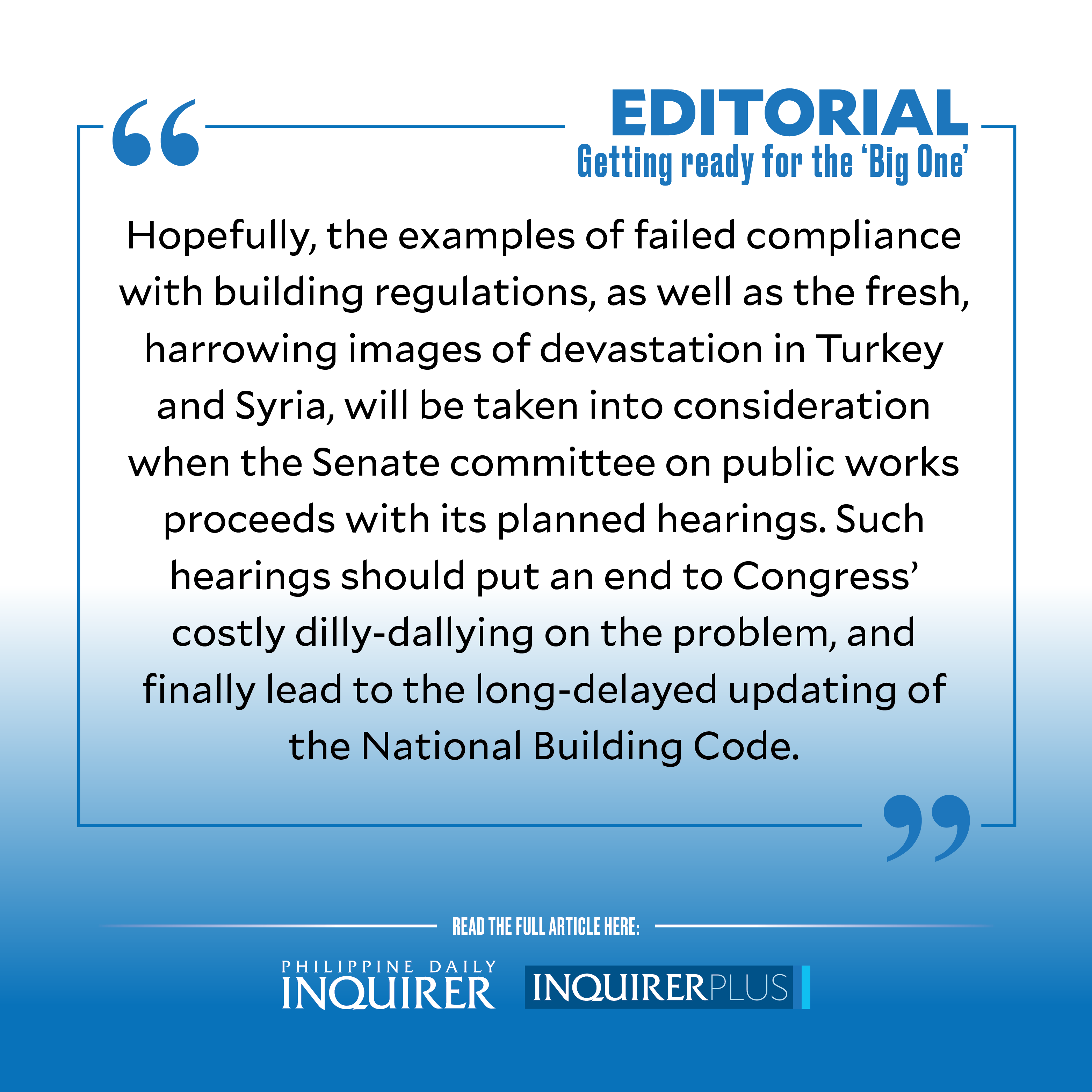Getting ready for the ‘Big One’

All too predictably, the massive 7.8-magnitude earthquake on Feb. 6 that devastated southeastern Turkey and parts of Syria, and claimed at least 40,000 lives, has triggered fresh calls from lawmakers to overhaul the 46-year-old National Building Code, and prepare the country for the much-dreaded “Big One.”
Sen. Francis Tolentino said early this week that amending provisions of the building code was “long overdue,” as it was crucial to ensure the structural integrity of establishments to minimize the loss of life and damage to property should a devastating quake hit, particularly in Metro Manila where most high-rise buildings are located.
Tolentino’s timely appeal, however, is nothing new.
In fact, the same sad refrain resurfaces every time a temblor hits the country. The same call was sounded by then House Speaker Alan Peter Cayetano following a series of deadly quakes in Mindanao in October 2019. When a 6.9-magnitude quake rocked Davao del Sur just a few weeks later, then Sen. Panfilo Lacson filed his proposed Philippine Building Act of 2019, calling for a similar “imperative” review of the building code. Lacson’s proposed reforms included the streamlining of the building classification and permit application process, the consideration of multiple hazards and new factors in building design, regulations for the assessment and maintenance of old buildings, and the grant of incentives for the use of environmentally sound and sustainable materials and technologies.
Unfortunately, any sense of urgency on the issue has since waned in Congress, which is preoccupied with Charter change and a sovereign wealth fund. But such inaction is something that the Philippines can no longer afford, given its geographic location along the Pacific Ring of Fire, and the natural deterioration of structures from continuous use through the years. Preparations for the “Big One” should be emphasized, as the consequences of failure are too frightening to contemplate.
Tolentino cited a study by the Metropolitan Manila Development Authority (MMDA) and the Japan International Cooperation Agency (Jica), which noted that many structures in the National Capital Region and nearby provinces would not able to withstand a 7.2-magnitude earthquake that experts believe can originate from the Marikina Valley Fault System, particularly the West Valley fault line. Based on the damage estimate by the 2004 Earthquake Impact Reduction Study for Metropolitan Manila, the potential rupture of the West Valley Fault will affect as many as 40 percent of residential buildings within Metro Manila: 170,000 residential houses will collapse while another 340,000 will be partly damaged, and 34,000 persons will die while 114,000 will be injured.
To mitigate the impact of such a strong earthquake, one of the “high priority” strategies that the study recommended as early as 2004 is the enforcement and passage of laws and regulations related to urban planning and the building code. Indeed, had the recommendations in the MMDA-Jica study been followed, perhaps some of the damage and loss of life resulting from a series of quakes that hit the country since then could have been avoided. Instead, Presidential Decree No. 1096 or the National Building Code of the Philippines issued in 1977 remains very much in use, despite the potential risks posed by changing conditions: buildings getting taller, occupancy going higher, typhoons becoming stronger, and temperatures getting warmer.
Lawmakers should immediately get started on updating the building code, and the government must ensure that its rules and regulations are strictly enforced, otherwise efforts to mitigate disaster would be useless. The government also should not wait for the code’s revision before conducting the necessary inspection of buildings, bridges, and other structures. The task force of the Department of Public Works and Highways that investigated the collapse of the Chuzon Supermarket in Porac, Pampanga, following a 6.1-magnitude quake in April 2019, found multiple structural and documentary defects in the building. The damage sustained was caused by the builders’ failure to comply with required referral codes, design plans and specifications, and proper construction supervision. The same was true for the buildings and structures that buckled under the Mindanao quakes. Former House deputy speaker Mikee Romero noted then that it was “abundantly clear that poor compliance with the National Building Code is part of the systemic reason for the deaths, injuries, and widespread damage in Mindanao.”
Hopefully, the examples of failed compliance with building regulations, as well as the fresh, harrowing images of devastation in Turkey and Syria, will be taken into consideration when the Senate committee on public works proceeds with its planned hearings. Such hearings should put an end to Congress’ costly dilly-dallying on the problem, and finally lead to the long-delayed updating of the National Building Code. Thousands of lives depend on it.




















